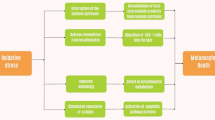Abstract
The pathogenetic mechanisms in vitiligo have not been completely clarified. One of the major hypotheses in the pathogenesis of vitiligo is the oxidative stress hypothesis. The active or stable phase of vitiligo is defined on the basis of the progression or appearance of new lesions in the last 3 months and the absence of new lesions or their progression in the last 6 months, respectively. Eighteen patients with active vitiligo, 18 patients with stable vitiligo, and 40 controls were included in this study. We examined serum levels of malondialdehyde, selenium, vitamin E and A, and the erythrocyte activities of glutathione peroxidase, superoxide dismutase, and catalase. Our results revealed a significantly higher level of serum malondialdehyde, selenium in patients with active disease compared with the controls. Significant higher increase in erythrocytes superoxide dismutase activities was observed in active vitiligo group, erythrocyte glutathione peroxidase activity was decreased significantly in active disease, whereas erythrocyte catalase activity and plasma vitamin E and A levels were not different in vitiligo patients as compared with controls. Our study shows that oxidative stress is involved in the pathophysiology of both active and stable vitiligo but increased imbalance of antioxidants was observed in the blood of active vitiligo patients.
Similar content being viewed by others
References
Aebi H (1984) Catalase in vitro. Methods Enzymol 105:121–126
Agrawal D, Shajil EM, Marfatia YS et al (2004) Study on the antioxidant status of vitiligo patients of different age groups in Borada. Pigment Cell Res 17:289–294
Asada K, Takahashi M, Nagate M (1974) Assay and inhibitors of spinach superoxide dismutase. Agric Biol Chem 38:471–473
Beazley WD, Gaze D, Panske A et al (1991) Serum selenium levels and blood glutathione peroxidase activities in vitiligo. Br J Dermatol 141:301–303
Bradford MM (1976) A rapid and sensitive method for the quantitation of microgram quantities of protein principle of protein-dye binding. Anal Biochem 72:248–254
Chakraborty DP, Roy S, Chakraborty AK (1996) Vitiligo, psoralen, and melanogenesis: some observations and understanding. Pigment Cell Res 141:301–303
Courtney B, Casp Jin-Xiong S, Wayne T et al (2002) Genetic association of the catalase gene (CAT) with vitiligo susceptibility. Pigment Cell Res 15:62–66
Dell’Anna ML, Maresca V, Brigandi S et al (2001) Mitochondrial impairment in peripheral blood mononuclear cells during the active phase of vitiligo. J Invest Dermatol 4:908–913
De Luca C, Gradinetti M, Stancato A et al (1997) Involvement of epidermal oxidative stress in vitiligo and pityriasis versicolor. Pigment Cell Res 10:356
Draper HH, Hadley M (1990) Malondialdehyde determination as index of lipid peroxidation. Methods Enzymol 186:421–431
Ducros V, Favier A (1992) Gas chromatographic–mass spectrometric method for the determination of selenium in biological samples. J Chromatogr 583:35–44
Hann SK (2000) Autocytotoxic hypothesis for the destruction of melanocytes as the cause of vitiligo. In: Hann SK, Nordlund JJ (eds) Blackwell, Oxford, pp 137–141
Latha B, Babu M. (2001) The involvement of free radicals in burn injury: a review. Burns 27:309–317
Lee BL, Chua SC, Ong HY et al (1992) High-performance liquid chromatographic method for routine determination of vitamins A and E and beta-carotene in plasma. J Chromatogr 1:41–47
Lemly AD (1997) Environmental implications of excessive selenium: a review. Biomed Environ Sci 10:512–522
Little C, O’Brien PJ (1968) An intracellular GSH-peroxidase with a lipid peroxide substrate. Biochem Biophys Res Commun 31:145–147
Maresca V, Roccella M, Roccella F et al (1997) Increased sensitivity to peroxidative agents as a possible pathogenic factor of melanocyte damage in vitiligo. J Invest Dermatol 109:310–313
Mosher DB (1999) Hypomelanoses and hypermelanoses. In: Freedberg IM, Eisen AZ, Wolff K, Austen KF, Goldsmith LA, Katz SI et al (eds) Fitzpatrick’s dermatology in general medicine. McGraw-Hill, New York, pp 945–1018
Nohl H, Hegner D (1978) Do mitochondria produce oxygen radicals in vivo? Eur J Biochem 82:563–567
Ogg GS, Dumbar PR, Romero P et al (1998) High frequency of skin-homing melanocyte-specific cytotoxic T lymphocytes in autoimmune vitiligo. J Exp Med 188:1203–1208
Paglia DE, Valentine WN (1967) Studies on the quantitative and qualitative characterization of erythrocyte glutathione peroxidase. J Lab Clin Med 70:158–169
Picardo M, Passi S, Morrone A et al (1994) Antioxidant status in the blood of patients with active vitiligo. Pigment Cell Res 2:110–115
Ross AC (1999) Vitamin A. In: Shils ME, Olson JA, Shike M, Ross AC (eds) Modern nutrition in health and disease, pp 305–327
Schallreuter KU, Wood JM, Berger J (1991) Low catalase levels in the epidermis of patients with vitiligo. J Invest Dermatol 97:1081–1085
Schallreuter KU, Wood JM, Pittelkow MR et al (1994) Regulation of melanin biosynthesis in the human epidermis by tetrahydrobiopterin. Science 263:1444–1446
Shaffrali F, Gawkrodger D (2000) Management of vitiligo. Clin Exp Dermatol 25:575–579
Teherani DK, Nagy-vezekenyi K (1986) Neutron activation analysis of some trace elements (selenium, chromium, cobalt and nickel) in the blood of vitiligo patients. J Radioanal Nucl Chem 104:53–58
Yildirim M, Baysal V, Inaloz HS et al (2003) The role of oxidants and antioxidants in generalized vitiligo. J Dermatol 30:104–108
Yohn JJ, Norris DA, Yrastorza DG et al (1991) Disparate antioxidant enzyme activities in cultured human cutaneous fibroblasts, keratinocytes, and melanocytes. J Invest Dermatol 97:405–409
Acknowledgement
We thank Dr Laporte François for his help in the serum selenium determination. (Dr. Laporte François. Laboratoire de Biologie du stress oxydant, UFR des Sciences Pharmaceutiques et Biologiques, Grenoble, France).
Prior to initiation of the study, each subject was informed about the purpose of the study and gives us an informed consent.
Author information
Authors and Affiliations
Corresponding author
Additional information
I dedicate this article to our dear director (Mme Hentati Basma) who dead in 06/06/06. We will never forget you and you are always in our heart.
Rights and permissions
About this article
Cite this article
Ines, D., Sonia, B., Riadh, B.M. et al. A comparative study of oxidant–antioxidant status in stable and active vitiligo patients. Arch Dermatol Res 298, 147–152 (2006). https://doi.org/10.1007/s00403-006-0680-2
Received:
Revised:
Accepted:
Published:
Issue Date:
DOI: https://doi.org/10.1007/s00403-006-0680-2




